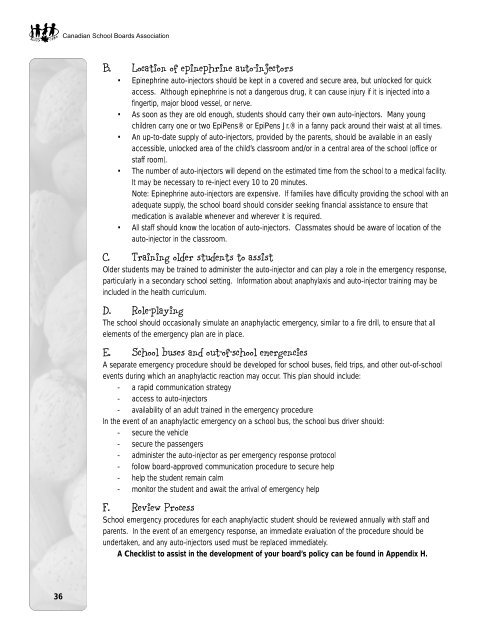Anaphylaxis - Canadian School Boards Association
Anaphylaxis - Canadian School Boards Association
Anaphylaxis - Canadian School Boards Association
Create successful ePaper yourself
Turn your PDF publications into a flip-book with our unique Google optimized e-Paper software.
<strong>Canadian</strong> <strong>School</strong> <strong>Boards</strong> <strong>Association</strong>B. Location of epinephrine auto-injectors• Epinephrine auto-injectors should be kept in a covered and secure area, but unlocked for quickaccess. Although epinephrine is not a dangerous drug, it can cause injury if it is injected into afingertip, major blood vessel, or nerve.• As soon as they are old enough, students should carry their own auto-injectors. Many youngchildren carry one or two EpiPens® or EpiPens Jr.® in a fanny pack around their waist at all times.• An up-to-date supply of auto-injectors, provided by the parents, should be available in an easilyaccessible, unlocked area of the child’s classroom and/or in a central area of the school (office orstaff room).• The number of auto-injectors will depend on the estimated time from the school to a medical facility.It may be necessary to re-inject every 10 to 20 minutes.Note: Epinephrine auto-injectors are expensive. If families have difficulty providing the school with anadequate supply, the school board should consider seeking financial assistance to ensure thatmedication is available whenever and wherever it is required.• All staff should know the location of auto-injectors. Classmates should be aware of location of theauto-injector in the classroom.C. Training older students to assistOlder students may be trained to administer the auto-injector and can play a role in the emergency response,particularly in a secondary school setting. Information about anaphylaxis and auto-injector training may beincluded in the health curriculum.D. Role-playingThe school should occasionally simulate an anaphylactic emergency, similar to a fire drill, to ensure that allelements of the emergency plan are in place.E. <strong>School</strong> buses and out-of-school emergenciesA separate emergency procedure should be developed for school buses, field trips, and other out-of-schoolevents during which an anaphylactic reaction may occur. This plan should include:- a rapid communication strategy- access to auto-injectors- availability of an adult trained in the emergency procedureIn the event of an anaphylactic emergency on a school bus, the school bus driver should:- secure the vehicle- secure the passengers- administer the auto-injector as per emergency response protocol- follow board-approved communication procedure to secure help- help the student remain calm- monitor the student and await the arrival of emergency helpF. Review Process<strong>School</strong> emergency procedures for each anaphylactic student should be reviewed annually with staff andparents. In the event of an emergency response, an immediate evaluation of the procedure should beundertaken, and any auto-injectors used must be replaced immediately.A Checklist to assist in the development of your board’s policy can be found in Appendix H.36


